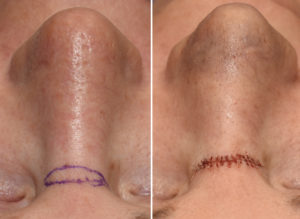Reshaping of the nasal tip is an important element of many rhinoplasty surgeries. Elevation of the nasal tip, known as increasing tip rotation, opens up the nasolabial angle and is commonly done in many female rhinoplasties. Having a nasolabial angle greater than 90 degrees (usually 95 to 105 degrees) is desired for the female nose. There are many technical maneuvers done to create this nasal tip change (cephalic trim, caudal septal resection, tip-septal suturing to name the most common) and they all can be very effective.
In rare cases direct ‘tip lifting’ techniques may not work well. This can occur in the nose that has had numerous surgeries and has developed thick scar tissue and lacks good skin retraction capabilities. Thicker scarred skin is harder to lift unless it is driven upward by a cartilage framework that is expanded to provide the underlying push. But building out the tip cartilages can make the nose too long and is not appropriate for all cases.
The older nose is also known to develop tip ptosis or sagging due to loss of ligamentous support from the tip cartilages. Thus it is true that the nose does elongate with age. Many older patients may not want to undergo a formal tip rhinoplasty for a tip rejuvenation benefit.

Because it is a skin excision, it will result in a fine line scar across the upper bridge of the nose. While this type of nasal incision can heal very well, it is best reserved for older patients who have developed some skin laxity. In older patients I have observed that the scar becomes imperceptible with time and scar maturation.
Dr. Barry Eppley
Indianapolis, Indiana



